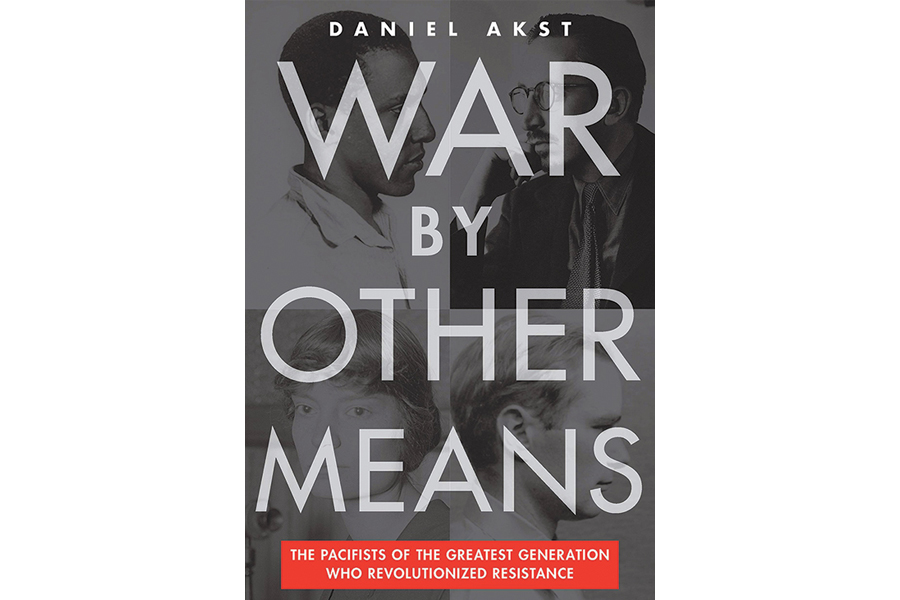War By Other Means: The Pacifists of the Greatest Generation Who Revolutionized Resistance
Originally published on June 1, 2023 in Friends Journal
Quakers have embraced the peace testimony since their founding in the seventeenth century. Less well known is the fact that their pacifist beliefs played a significant role in the interwar years of the twentieth century. This was a time when Quakers were joined by a growing community of war resisters that emerged from the boiling ideological cauldron of isolationism, Marxism, socialism, and activist social-gospel Christianity. When the United States entered World War II after the bombing of Pearl Harbor, public opinion shifted from isolationist to strongly pro-war, leaving these pacifists marginalized and even persecuted but not deterred.
Daniel Akst explores this fascinating history in War By Other Means: The Pacifists of the Greatest Generation Who Revolutionized Resistance. Akst argues persuasively that the war resisters, strengthened by their experiences opposing WWII, were critical in shaping major progressive movements of the second half of the twentieth century: civil rights, nuclear disarmament, ending colonialism, overturning apartheid, and ending the war in Vietnam. “In the history of progressive change in this country,” he writes, “resistance to the Second World War is the crucial missing link.”
War By Other Means is built around four key figures: David Dellinger, Dwight Macdonald, Dorothy Day, and Bayard Rustin. All were pacifists, but only Rustin was a Quaker. He was a brilliant thinker and organizer—Black and openly gay—who after WWII became part of Martin Luther King Jr.’s inner circle and a key strategist of the Civil Rights Movement, including organizing the 1963 March on Washington. Raised in suburban Philadelphia, Pa., by his Quaker grandparents, Rustin had many early Quaker influences, including participating as a student in a 1937 peace conference and other events organized by American Friends Service Committee, which he claimed opened his eyes to larger social concerns.
Dellinger and Macdonald both came from America’s social elite and shared an antipathy to authority. Dellinger went to prison as a conscientious objector (CO) in WWII and remained a pacifist and radical activist his entire life. He is perhaps best known as one of the “Chicago Seven” arrested for protesting the Vietnam War at the Democratic National Convention in 1968. Macdonald in 1944 founded the influential pacifist magazine politics, which advocated for the rights of COs, Black Americans, and gay Americans. After it folded, he made his career as a writer among New York’s intellectual circles.
Day converted to Catholicism in 1926 at age 29, and founded the Catholic Worker Movement, a network of settlement houses serving the poor. In 1933, she launched the Catholic Worker, an ardently pacifist newspaper. An unorthodox but devout Catholic, she wrote in 1936, “My absolute pacifism stems purely from the gospel.”
In the late 1930s, the traditional “peace churches”—the Religious Society of Friends, Mennonites, and the Church of the Brethren—worked feverishly to develop a framework for alternative service for COs, and proposed the Civilian Public Service (CPS) in early 1940. Military conscription started on October 16, 1940, when all eligible men were expected to register on a single day. Those who identified themselves as COs largely complied. An estimated 25–50,000 COs served in noncombatant roles in the armed services. Approximately 12,000 were assigned to the 152 CPS camps scattered across the country, performing unpaid labor building roads and trails, firefighting, running farms, creating dams and reservoirs, and even digging ditches. But more radical war resisters refused to register, determined not to support the machinery of war in any way. About 2,000 went to prison, where harsh conditions hardened their resolve. In prison they took up the cause of segregation and the harsh treatment of Black people, creating solidarity across race and class lines.
Rustin, for example, refused to tolerate segregation at the medium-security federal prison where he was incarcerated in Ashland, Ky. He was quickly labeled a ”troublemaker” and “extremely capable agitator” by prison officials, but he organized so effectively that eventually they allowed interracial seating in church, movies, and the dining room—a small victory for nonviolent dissent. These tactics and techniques war resisters practiced in prison became lessons in nonviolent protest that were deployed in the national civil rights struggle after the war.
About 3,000 COs, like Quaker Warren Sawyer of New York, volunteered to work in mental institutions under appalling circumstances, and some also participated in dangerous medical experiments. They pushed for systemic reform by documenting conditions in the hospitals and working with journalists to expose abuses, while trying new and nonviolent ways to ameliorate the lives of patients. Akst includes first-hand accounts of these experiences, including one from Sawyer:
“This is a perfect setting in which to demonstrate the superiority of pacifism over brute force in handling tense situations,” Sawyer wrote. “If you can convey to patients that you’re not afraid of them and respect them as individuals—even though you’re shaking in your boots—they return your respect.”
Akst believes that the people he writes about were wrong about refusing to fight in the Second World War but right about many other things. Indeed, he says, “the pacifists of World War II helped make the country many of us take for granted: a nation that approves of gay marriage, grants women something approaching equality, and elected a black president named Barack Hussein Obama.” Akst is not a pacifist, but he has written a sympathetic and compelling story of pacifists’ courage and the enduring impact of their testimony.
